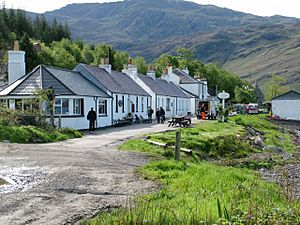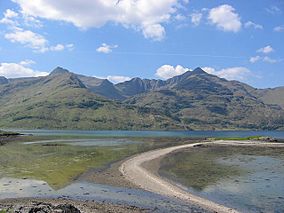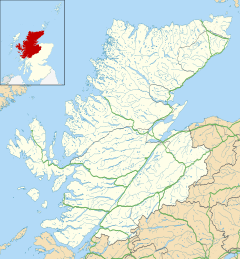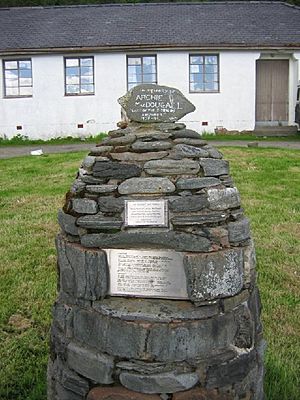Knoydart facts for kids
Quick facts for kids Knoydart
|
|
|---|---|
 Inverie on the Knoydart peninsula |
|
| Population | 157 |
| Council area | |
| Lieutenancy area | |
| Country | Scotland |
| Sovereign state | United Kingdom |
| Post town | MALLAIG |
| Postcode district | PH41 |
| Dialling code | 01687 |
| EU Parliament | Scotland |
| UK Parliament |
|
| Scottish Parliament | |
| Knoydart National Scenic Area | |
|---|---|

Ladhar Beinn from Eileann Choinneach
|
|
| Location | Lochaber, Scotland |
| Area | 507 km2 (196 sq mi) |
| Established | 1981 |
| Governing body | NatureScot |
Knoydart (Scottish Gaelic: Cnòideart) is a beautiful peninsula located in Lochaber, Highland, on the west coast of Scotland. It sits between two sea lochs: Loch Nevis and Loch Hourn. Some people say these names mean "Loch Heaven" and "Loch Hell," but this is just a poetic idea.
Knoydart is often called "Britain's last wilderness." This is because it's very remote and has tough terrain. You can only reach it by boat or by walking 16 miles (26 km) through rough country. The few roads here are not connected to the main UK road system.
The area is part of Scotland's national scenic areas. These are special places known for their amazing views. They are protected to keep them beautiful. The Knoydart area covers about 507 square kilometers (196 square miles). Most of this is land, with some sea area too.
Knoydart is a popular spot for people who love the outdoors. Many enjoy hill walking, mountaineering, sailing, and watching wildlife. It has several tall mountains called Munros, like Ladhar Bheinn (1020 m) and Sgurr na Cìche (1040 m). There are also six slightly smaller mountains called Corbetts.
Contents
Knoydart's Past: A Journey Through Time
Knoydart has a long and interesting history. It was once part of a kingdom ruled by a powerful leader named Somerled in the 1100s. Later, it was owned by different branches of the Clan Donald family for many centuries. In the early 1600s, the Clan MacDonell of Glengarry took control of Knoydart.
Before the 1745 Jacobite rising, nearly a thousand people lived here. Many people left Knoydart over the years, often moving to Canada. For example, Knoydart, Nova Scotia in Canada is named after this Scottish community. Even with people leaving, the population stayed high, almost a thousand in 1841.
The Highland Clearances in Knoydart
A sad part of Knoydart's history is the Highland clearances. In 1852, about 400 people were told they had to leave their homes. They were offered boat trips overseas, first to Australia, then to Canada. On August 9, 1853, 330 people from the west coast of Knoydart sailed to Canada on a ship called the Sillery.
However, 11 families, more than 60 people, refused to go. Their story became famous as part of the Clearances. The MacDonell family finally sold Knoydart in 1856. It was bought by James Baird, a wealthy iron businessman from Ayrshire.
James Baird bought the estate in 1857 for £90,000. He built several new houses in Knoydart, similar to those he built for his factory workers. After he died in 1876, his nephew, John Baird, took over. The ownership of Knoydart changed many times throughout the 20th century.
During World War II, Knoydart was a "Protected Area" and became very busy with military people. After the war, the military left, and the number of civilians also went down.
The Seven Men of Knoydart
In 1948, a group known as the "Seven Men of Knoydart" tried to claim land on the estate for themselves. They wanted to start small farms, called crofts. But the estate owner, the Second Baron Brocket, fought against them. A court ruled against the men, and their appeal to the government was also rejected. The Seven Men eventually gave up their fight.
Knoydart Today: Community Ownership
The Knoydart Foundation was started in 1997. Its goal was to buy and manage a large part of the peninsula, including the village of Inverie. The Foundation is a charity and bought the estate in 1999. It's a team effort, involving local people, the Highland Council, and other groups like the John Muir Trust.
The Foundation's aim is to manage the Knoydart Estate. They want to create jobs and keep people living there. They also work to protect its natural beauty, wildlife, and local culture. Other parts of Knoydart are owned by different private estates.
Life in Knoydart: Infrastructure and Services
Inverie is the main village on the peninsula. About 98 adults live there. It has a post office, a primary school, a small brewery, and places for visitors to stay. These include bed and breakfasts, bunkhouses, and self-catering homes.
The Old Forge Inn, Knoydart's only pub, is famous for being the most remote pub on mainland Britain. You can only reach it by walking 18 miles (29 km) or taking a 7-mile (11 km) boat trip. The community bought the pub in 2022 and made important repairs. It's expected to attract many visitors.
Getting Around Knoydart
A vehicle track runs from Inverie to a smaller village called Airor, about 8 miles (13 km) away. This track passes other small settlements like Scottas and Doune. It's a public road, but you need a special permit to drive on it.
A ferry service runs from Mallaig to Inverie. This ferry is supported by the Highland Council. There are also private boat operators who offer passenger and equipment services.
Powering the Community
Knoydart is not connected to the main national electricity grid. Instead, it gets its power from a hydro-electric scheme. This scheme uses water to create electricity for Inverie. It's run by a community trust called Knoydart Renewables. The system relies on volunteers, and the community is working on plans to keep the power supply reliable for the future.
In 2005, a new energy company held its first meeting in Inverie. A new pier was opened in Inverie in 2006. In 2019, the Knoydart Foundation celebrated 20 years of community ownership. They are also raising money to fix up the Knoydart Community Hall. This hall is a vital place for meetings, events, and activities for the whole community.
Knoydart's Natural Environment
The land in Knoydart is mostly made of old rocks like mica-schist and quartz. The landscape shows many signs of the ice age. You can see deep, fjord-like sea lochs, hanging valleys, and bowl-shaped hollows called corries.
Forests and Wildlife
You'll find birchwoods on the steep slopes and along the coast. There are also some areas of ancient Caledonian pinewoods. In the past, too many sheep and now too many red deer have eaten young trees. This has reduced the amount of forest. To help the forests grow back, the deer population is managed by controlled hunting.
Knoydart is home to many animals. You might spot badgers, pine martens, otters, and red deer. Birds like buzzards, golden eagles, and sea eagles fly overhead. There are also two small groups of feral goats. You can visit a wildlife hide near Inverie beach to watch animals. The seas around Knoydart are important for harbour porpoises and are protected.
Images for kids







